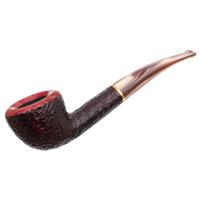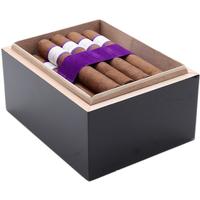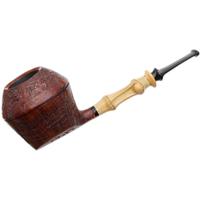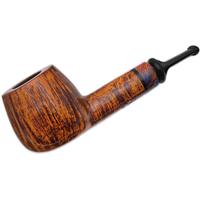I smoke one shape (pot/Canadian) basically and they are made by one maker (Castello) so wall thickness, stem length, bowl diameter and depth are very consistent. You can also make a reasonable assumption that the air/fuel mix is pretty much the same across the pipes yet I find one will smoke a blend genre better than the others. This I put down to the piece of briar and the way it imparts it’s natural nuance is why one smokes Virginia’s better or one of the other genres better than others.
Why do Pipes Taste Different?
- Thread starter Sigmund
- Start date
You are using an out of date browser. It may not display this or other websites correctly.
You should upgrade or use an alternative browser.
You should upgrade or use an alternative browser.
I loved Penzance when a friend gifted me a generous sample a few years ago. With the comment that he found it “disappointing and not living up to the hype”
I loved it.
And chased some down.
About 18 months back I noticed I was not finishing bowls of Penzance as I was finding the smoke “boring”
Fast forward to a couple of months back - I decided to try Penzance in different pipes of different materials, different chamber dimensions and differing airway diameter
These results are by no means objective - just my opinion.
And based on a limited number of smokes.
1). The airways diameter was the biggest factor. I much preferred a tighter draw. An open draw resulted in less concentration of flavour.
2). Morta seems to accentuate the “smokiness and (?)incense-like” characteristics
3). Smaller chambers preferred. I have a short attention span and easily get bored if the smoke goes on for more than 35-40minutes
Will update in WAYS of ongoing trials.
I do bear in mind that taste is very subjective. And much is between one’s two ears
I loved it.
And chased some down.
About 18 months back I noticed I was not finishing bowls of Penzance as I was finding the smoke “boring”
Fast forward to a couple of months back - I decided to try Penzance in different pipes of different materials, different chamber dimensions and differing airway diameter
These results are by no means objective - just my opinion.
And based on a limited number of smokes.
1). The airways diameter was the biggest factor. I much preferred a tighter draw. An open draw resulted in less concentration of flavour.
2). Morta seems to accentuate the “smokiness and (?)incense-like” characteristics
3). Smaller chambers preferred. I have a short attention span and easily get bored if the smoke goes on for more than 35-40minutes
Will update in WAYS of ongoing trials.
I do bear in mind that taste is very subjective. And much is between one’s two ears
When you clean your teeth also clean you tongue. 
Having read numerous posts on this topic as well as the tinned VS bulk versions of the same blend, I've come to the inevitable conclusion that "suggestion" plays a significant role in a lot of it.Just out of curiosity, for those that find big differences between pipes, did you think so before or after you heard someone else say it? Suggestion can have a big influence on perception. I hadn't talked to another pipe smoker for the first 20+ years of smoking and only heard about the idea of differences here for the first time in 2014.
Power of suggestion is so strong that it works even if you know it is suggestion.Having read numerous posts on this topic as well as the tinned VS bulk versions of the same blend, I've come to the inevitable conclusion that "suggestion" plays a significant role in a lot of it.
I occasionally read the good reviews to know what I should be tasting while smoking and of course those bowls are more satisfying.
However there is no absolute reality: If suggestions make your experience different then those experiences are “real”.
I dug up this post from Trever Talbert on the issue of differences in briar and, some tasting differences:
Worth reading. He says it's difficult to know the origin of the briar and the taste variations are dwarfed by other influences. However, his last comments describing the 'signature' taste (if there can be such a thing) of the various briars is interesting:
This is the link: http://www.talbertpipes.com/2007/04/are-there-really-differences-in-briar.htmlAre there really differences in briar?
Biz Stuff - I've just uploaded two new Morta Classics and two new Ligne Bretagne Collectors to the website catalogs, for those who may be interested. There's a green one...
Also, check the News page for info on the further tweaking of the website, including the new estimated dollar pricing in the catalogs.
Today's pic is the pile of stuff I just got in the mail - LOTS of new drill bits, including some experimental ones, plus more bundles of delrin rod. I ordered a few half-round bits to try on airhole drilling - We'll see how they do.
The subject of this post is a topic that arose on a pipe forum I frequent. Are there really differences in the country of origin for briar? Some people will swear by Corsican, or Algerian, or Italian, claiming that these different regions of briar produce superior flavor in pipes. But is this true?
Yes and no.
Before I answer further, consider - No one really knows where their briar comes from. Seriously. Briar mills buy briar burls from all over the place, different countries, different suppliers, and they're all mixed together in cutting and drying. The mill you buy from may be in Italy, but that's no guarantee that their briar is all Italian - It could be from anywhere around the Med. So, anytime someone says that their briar is definitively of this or that origin, take it with a grain of salt.
Past this point, there are two major arguments - Briar is briar versus the contention that briar varies noticeably from source to source. To address that second argument, we've got to first break down just what "good" means in briar. ANY briar source can produce beautifully-grained, excellent smoking wood.... but there are variances. If you want a block that's likely to be less badly flawed in terms of bald spots or cracks, this depends much more on the cutter that one is buying from than on the origin country of the wood.
I've worked with briar from many different sources, and I have the rare ability to be able to actually comparison smoke different briars. To know that both pipes are drilled with the same size of bowl, the same chambers, the same airhole size, and utilize the same stem material.... because ALL of these factors also influence the flavor of the smoke! Smoke the same pipe with an ebonite and an acrylic stem swapped out, and you'll be surprised at the flavor difference. So, already we're looking at an equation that's nearly impossible to boil down to simple measurements - Someone who thinks they like Algerian briar because they believe a brand they like uses Algerian briar may just as easily be responding to the stem design this brand uses, or the airhole layout and size. Too often, big generalizations are made regarding the quality of briar from different countries, often on quite shaky evidence.
But IS there a difference? I can give a very qualified yes. Smoking the same tobacco in identical pipes made from two different briar sources, I can - sometimes - detect a very small flavor difference. In order to notice this difference, I have to actually be smoking the same tobacco in both pipes back-to-back, and on the same night - swapping one with the other every few puffs, because if I smoked them a day apart I would never detect any difference, it is often so minute.
Which of course begs the question - How do I know that the difference between the Greek briar block and the Algerian briar block is down to the source, or rather just the natural variance between two random blocks of briar? I can't. Not all Greek briar smokes the same, nor all Italian. One just has to take what nature deals and make the best of it. If pressed, I have *generally* noticed the following minor characteristics, but they're definitely subtle. Algerian briar, to me, seems to offer a darker, richer, heavier flavor. Greek seems extremely neutral, allowing the tobacco itself to shine. Italian and Corsican seem "bright", giving blends a sharper edge. At least in my experience. But often none of these things are true. It's like that, in nature...
Posted by Trever Talbert on Wednesday, April 18, 2007 at 10:53 PM |
Worth reading. He says it's difficult to know the origin of the briar and the taste variations are dwarfed by other influences. However, his last comments describing the 'signature' taste (if there can be such a thing) of the various briars is interesting:
If pressed, I have *generally* noticed the following minor characteristics, but they're definitely subtle. Algerian briar, to me, seems to offer a darker, richer, heavier flavor. Greek seems extremely neutral, allowing the tobacco itself to shine. Italian and Corsican seem "bright", giving blends a sharper edge. At least in my experience. But often none of these things are true. It's like that, in nature...
It’s been touched on here in this discussion but the bit and how the smoke is passed over your palette will impact in quite a significant way. I know there are two master blenders who are currently exploring this and it makes sense. Oriffic vs Fishtail vs P-Lip clearly must offer a different experience.
I've noticed differences between pipes with the same tobacco. I love Haunted Bookshop in a briar. Tried it in a cob one day and it just tasted sour and musty. Dumped the bowl onto a plate, loaded the same tobacco into the briar and it tasted delicious as expected. No idea why.
I do not understand the "why" of it, I just know that it is true.
When it comes to tasting tobacco smoke, I do not have great powers of discernment. If I concentrate, I can make out differences among components but, for the most part, a smoke either tastes pleasant to me, and is free of harshness, or it isn't. I prefer the mellower taste of Virginia-based blends to the more assertive taste of, for example, English or Lakeland blends, but I enjoy those blends from time to time too.
Some pipes seem to produce the pleasant smoke I'm looking for more consistantly than others (usually regardless of the blend). But I've never gotten to the point where I can say one good pipe smokes a particular VaPer better than another one. And I'm pretty sure that the differences I'm able to detect between one pipe and another—and even between a better and worse smoke in the same pipe—have more to do with me than with the pipe. Otherwise, I'd never have a bad smoke.
But as I said, I don't have great powers of discernment. I can well believe that other pipe smokers do.
Some pipes seem to produce the pleasant smoke I'm looking for more consistantly than others (usually regardless of the blend). But I've never gotten to the point where I can say one good pipe smokes a particular VaPer better than another one. And I'm pretty sure that the differences I'm able to detect between one pipe and another—and even between a better and worse smoke in the same pipe—have more to do with me than with the pipe. Otherwise, I'd never have a bad smoke.
But as I said, I don't have great powers of discernment. I can well believe that other pipe smokers do.
Last edited:
Definitely taking this thread off piste -
I have posted this previously.
I have been drinking wine since the late ‘60s and have participated in a lot of “tastings” since.
In the early ‘80s Riedel glasses burst on the wine scene.
Like many I was sceptical at the claims of how much a different shaped or different sized bowl could influence the taste of a wine.
Not to mention the prices.
I have organised glass tastings with up to 6 (different) glasses - involving wine, cognac, whisky, rum and grappa/eau de vie
Participants include amateurs (wine-loving friends) and professionals (wine merchants, importers and writers)
There is an undeniable discernible difference.
So yes, size and shape of the bowl makes a difference.
Different materials ? Definitely
Different briars ? Very possibly. But my palate is not sufficiently finely tuned to be categorically certain
I have posted this previously.
I have been drinking wine since the late ‘60s and have participated in a lot of “tastings” since.
In the early ‘80s Riedel glasses burst on the wine scene.
Like many I was sceptical at the claims of how much a different shaped or different sized bowl could influence the taste of a wine.
Not to mention the prices.
I have organised glass tastings with up to 6 (different) glasses - involving wine, cognac, whisky, rum and grappa/eau de vie
Participants include amateurs (wine-loving friends) and professionals (wine merchants, importers and writers)
There is an undeniable discernible difference.
So yes, size and shape of the bowl makes a difference.
Different materials ? Definitely
Different briars ? Very possibly. But my palate is not sufficiently finely tuned to be categorically certain
Last edited:
I’m a brewer & I originally thought the same thing about beer specific glassware. I remember when Sam Adams had a glass designed for their Boston Lager. I thought, will it really taste all that different than it does out of a pint/mug/mason jar? It did. Very noticeably. Then I discovered the wonderful world of Belgian beer & how most breweries have a glass designed to enhance their beers, sometimes one for each style. Same results. Even if you try the same style in another brewery’s glass! It might just be the power of suggestion, but the glasses look cool & I get to act like I’m some kind of expert.Definitely taking this thread off piste -
I have posted this previously.
I have been drinking wine since the late ‘60s and have participated in a lot of “tastings” since.
In the early ‘80s Riedel glasses burst on the wine scene.
Like many I was sceptical at the claims of how much a different shaped or different sized bowl could influence the taste of a wine.
Not to mention the prices.
I have organised glass tastings with up to 6 (different) glasses - involving wine, cognac, whisky, rum and grappa/eau de vie
Participants include amateurs (wine-loving friends) and professionals (wine merchants, importers and writers)
There is an undeniable discernible difference.
So yes, size and shape of the bowl makes a difference.
Different materials ? Definitely
Different briars ? Very possibly. But my palate is not sufficiently finely tuned to be categorically certain
All that being said, the Poplar Camp I’m smoking this morning in my bent Bulldog tastes different than the PC I smoked in my Marxman Jumbo Billiard on Thursday.
Even if it’s all hocum, it’s fun to experiment & find that perfect marriage of pipe & tobacco. It’s a great excuse to acquire different pipes for research as well!
Lots of reasons, but if I had to pick two I would say the quality of the briar and the curing. One cool thing about meerschaums. I have several and they all smoke the same.... neutral and good. 

Most of my pipes are bent billiards and being similar too each other, the tobacco smokes and taste similar to the other pipes. I don't smoke enough of a variety of tobaccos to comment on different tobaccos but recently I have been trying to get used to D&R Three Sails which is a bright virginia blend with an extra fine shag cut. It always seems to burn fast and hot. Today I tried some in a Peterson Xl339S which has a smaller chamber (19.5mmx38.5mm)...I could finally taste some traditional virginia flavor. So for an extra fine shag cut a thinner smaller chamber does seem to impact taste based upon my onetime experience. YMMV. Packing tighter or lighter can also effect the duration of the smoke though perhaps not the flavor.
Two Cents.
Two Cents.
Absolutely! But after the pipe has formed a cake, and is fully broken in, one's body chemistry, what was smoked previously, one's mood, feelings about the pipe, state of the new tobacco, what was recently eaten or drunk, and how Venus and Mars line up become important.Lots of reasons, but if I had to pick two I would say the quality of the briar and the curing. << Snipped bits out >>
Anybody who agrees with me is always right.
Xxxx
Algerian briar, to me, seems to offer a darker, richer, heavier flavor. Greek seems extremely neutral, allowing the tobacco itself to shine. Italian and Corsican seem "bright", giving blends a sharper edge. At least in my experience. But often none of these things are true. It's like that, in nature...
Posted by Trever Talbert on Wednesday, April 18, 2007 at 10:53 PM |
Xxxxx
But is that, because the over 70 year old, gnarly carved big Marxman pipes I see in my bins all colored various shades of oxblood, and made by long dead hands at 27 West 24th Street NYC, I think are supposed to give me the hiccups smoking Carter Hall, so I make them smoke that way?
We can’t know.
Xxxx
Algerian briar, to me, seems to offer a darker, richer, heavier flavor. Greek seems extremely neutral, allowing the tobacco itself to shine. Italian and Corsican seem "bright", giving blends a sharper edge. At least in my experience. But often none of these things are true. It's like that, in nature...
Posted by Trever Talbert on Wednesday, April 18, 2007 at 10:53 PM |
Xxxxx
But is that, because the over 70 year old, gnarly carved big Marxman pipes I see in my bins all colored various shades of oxblood, and made by long dead hands at 27 West 24th Street NYC, I think are supposed to give me the hiccups smoking Carter Hall, so I make them smoke that way?
We can’t know.
After hearing the latest smoking pipes podcast with Brian, stain may also be added to the list.Lots of reasons, but if I had to pick two I would say the quality of the briar and the curing. One cool thing about meerschaums. I have several and they all smoke the same.... neutral and good.
I believe the variables are going to affect the smoking experience too much for a clear answer. How the pipe is packed, the chamber width and height, relative humidity, how you’re drawing on the pipe, are all factors that are going to potentially change how the tobacco is burning and ultimately how it tastes. What you ate and drank might affect your perception of these things.
I would find it a bit more interesting for you to cut down on the variables and try smoking the same tobacco (packed as close to the same way you normally do if possible) in two pipes of the same model (the two pipes might have slight variations that could affect things, but hopefully being from the same company will be close to identical) and smoke them to see if you get the same experience (“wow” or “okay”). Again, this may be futile and bound to be different because smoking them at different times will alter the scenario. You might the biggest variable. More nicotine in your system, palate fatigue. Alternating pipes and smoking at the same time might not be close enough to being the same. Maybe the answer in unknowable. This reminds me of an Oblique Strategy card (Oblique Strategies are a set of over 100 cards with various aphorisms printed on them to use as advice in the creative process to help get past creative blocks—there are at least five editions with slight variations of the number of cards and what they say) by musician Brian Eno and artist Peter Schmidt that says, “Repetition is a form of change.”
I wasn't expecting an Oblique Strategies reference here! I bought a deck for my wife for Christmas, and she loved it.

Photos, please... unless it was a deck of cards. Or a tape deck.I wasn't expecting an Oblique Strategies reference here! I bought a deck for my wife for Christmas, and she loved it.
I definitely taste differences between pipes, whether it's the briar type or the chamber dimensions, or what I have smoked in that pipe through a decade of owning it, etc...
Wine glasses do influence the taste of wines, as the aroma greatly affects the taste, so the way the glass is shaped affects the way it captures the vapors.
Only a small percentage of people have the capability of tasting deeply into something, and even out of those a far fewer have bothered to train their senses to use that capability. I have stopped being surprised at people on here that can't taste. They tend to throw insults at those who do taste deeply. It's just a jealousy thing. To each their own. The irony is that some of them will chase down the most obscure European... anyways :::cough cough::: Just know that you aren't crazy. Many of us know what you mean. On the OP, there are a lot of variables, so I don't think anyone can pinpoint exactly why that is. It's just a part of the magic.
Wine glasses do influence the taste of wines, as the aroma greatly affects the taste, so the way the glass is shaped affects the way it captures the vapors.
Only a small percentage of people have the capability of tasting deeply into something, and even out of those a far fewer have bothered to train their senses to use that capability. I have stopped being surprised at people on here that can't taste. They tend to throw insults at those who do taste deeply. It's just a jealousy thing. To each their own. The irony is that some of them will chase down the most obscure European... anyways :::cough cough::: Just know that you aren't crazy. Many of us know what you mean. On the OP, there are a lot of variables, so I don't think anyone can pinpoint exactly why that is. It's just a part of the magic.










